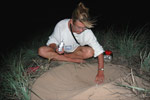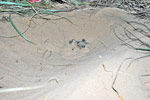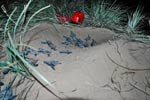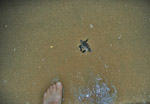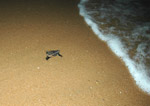|
|
|
Mother Nature at her best
The miracle of Moore Park
Beach
|
Story and Photos by DENNIS AMOR |
WE NOW know how archaeologist and Egyptologist Howard Carter must have
felt as he rummaged around in the mystical Valley of the Kings.
Agreed, our quest may not have been in such a romantic and historic place
but our objectives were somewhat similar. While Carter combed vast areas
of sandy terrain hunting the tomb of boy pharaoh Tutankhamen, we were
targeting kilometres of sand for entombed baby turtles!
And, just like Carter all those years ago, our tireless efforts were
finally rewarded after what seemed like an eternity searching for those
elusive and endangered marine creatures.
We felt privileged and were spellbound as scores of baby turtles, no more
than a few centimetres long, slowly dug their way out of their sandy egg
chamber and scurried off to an unknown and uncertain future in the vast
waters of the Pacific Ocean.
It was Mother Nature at her best when the sand delivered its precious
clutch of 100 or more baby loggerheads on the beach at Moore Park Beach,
about 21km north of Bundaberg in Queensland., Australia.
My wife Patricia and I had spent five frustrating evenings combing every
metre of the foreshore along a four-kilometre stretch of beach searching
for evidence of hatchlings beginning their fascinating and treacherous
journey into life.
We were about to abandon our search on the moonlit beach when a telephone
call from local turtle coordinator Judi Giarola had us dashing nearly a
kilometre to where a nest was about to deliver its precious treasure trove
of babies.
A miracle of Moore Park Beach was about to unfold.
We sat spellbound for more than three hours as telltale signs – grains of
sand moving, subsidence and strange shapes appearing on the surface –
indicated the hatchlings had begun digging their way through the sand to
the surface.
Then suddenly the metre-wide nest erupted like a volcano, spewing scores
of hatchings into the night air. Amazingly and almost en-masse, these tiny
creatures slowly turned towards the ocean and headed towards the surf.
And as if on cue a crab suddenly appeared … it was the hatchlings’ first
brush with danger, which sees only one in a thousand reach maturity. This
time they were lucky. We were on hand to quickly ward off the impending
crab attack!
Extraneous lights can easily disorientate the hatchlings and this leads to
many deaths. But anticipating this, my wife grabbed her torch and led the
fortunate tribe to the water’s edge. She was, so to speak, the Pied Piper
of Moore Park Beach!
Judi explained how she had stumbled across the nest 10 days previously
when heavy rains exposed the eggs. Expertly she relocated them, ensuring
they were positioned the correct way up, and re-covered them with sand.
These fortunate hatchlings had survived the land dangers, though many more
hazards faced them in the ocean. They are tasty morsels for sharks and
other fish and sea dwellers.
But Judi told us that sadly many more fall prey to mankind. Green turtles
are much sought after in tropical countries for their eggs and meat. Baby
green and loggerhead turtles often fall victims to trawlers and their
nets, though things have improved with the introduction of compulsory
‘turtle friendly’ nets which now offer an escape route for them, she said.
Though deemed a vulnerable species, I’m happy to report that research
indicates a slight turnaround in this marine creature’s misfortunes.
A few years ago their numbers had plummeted to an all-time low but
scientists monitoring turtle numbers say more and more of these long-lived
ocean dwellers are returning to our shores.
Marine turtles grow very slowly and reach sexual maturity after 30 to 50
years. Astonishingly, nesting females will return to lay their eggs in the
same area where they were born..
Scientists believe hatchlings are imprinted with the earth’s magnetic
field and smell of the waters near the nesting beach.
Courtship and mating – females gather sperm from several males – occur in
shallow waters near the breeding beaches. Females can lay up to six
clutches of eggs several weeks apart, a clutch comprising up to about 160
soft white eggs the size of a table tennis ball.
But the Southern Hemisphere's most important loggerhead turtle rookery ‒
Mon Repos, near Bundaberg in Queensland, Australia ‒ even recorded one clutch of 206
eggs..
Incubation, size and sex are thought to be governed by the temperature and
colour of the sand in which the eggs are laid. Researchers have found that warm,
dark sand produces mostly females while eggs in cool, white sand yield
male hatchlings.
Nesting at Moore Park Beach and nearby beaches is from late October to
early March. Hatchlings appear approximately 52 to 64 days after eggs are
laid.
BACK TO CARAVANNING NEWS MAIN PAGE
SEND YOUR COMMENTS OR
STORY IDEAS TO
CARAVANNING NEWS

No part of this
publication may be reproduced or transmitted without
the prior written
permission of Dennis Amor.
Copyright 2005
Dennis Amor
All Rights Reserved
|
|
|
|
|
|

